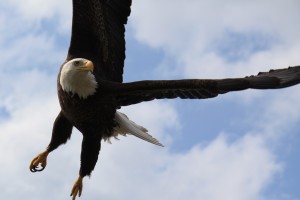Though it had no airline flights, highways or cruise ships 100 years ago, the Kenai Peninsula still drew visitors, both of the human and feathered varieties.

It was from records of human visitors at the turn of the 20th century that Todd Eskelin, a fish and wildlife biologist at the Kenai National Wildlife Refuge, began to piece together a history of bird populations on the Kenai Peninsula.
Documentation from three exploratory expeditions to Alaska in 1899, 1900 and 1901 give a glimpse of some changes that have taken place, and individual birders over the years have added observations to that long-lived knowledge base.
“None of the information that we have from the Kenai and Kasilof flats is state- or government-sponsored surveys,” Eskelin says. “It really is individual birders, and not scientists, that are paid to go and generate the information that tells us how important these spots are.”
A century ago, common eiders were indeed common around Kachemak Bay. Today only a few are found during winter and early spring.
Then there’s species like the northwest crow. It’s abundant around Kenai today, but a century ago they only ventured as far northwest as Valdez.
The three-toed woodpecker is another ubiquitous bird on the Peninsula that was only documented once by early expeditions. Those early birding trips also didn’t find black-capped chickadees, American robins, northern pintails and American wigeons — all of which can be found these days.
Bald eagles are another relative newcomer. They used to be more transient birds to the Kenai area, visiting when natural food sources were available and leaving when not. But once they became accustomed to human-generated meals, they started staying year-round. Eskelin has seen as many as 800 in one day at the landfill.
“A lot of these fed populations of bald eagles just tend to not go back to their breeding grounds.… But the good part of the story is they’re not making babies, so they’re not teaching their babies to come to dump.”
On the flip side, the once-common sighting of snow geese on the Kenai River flats has drastically diminished.
The flats in general have been experiencing a 30-year drying trend, but it’s still an incredibly important habitat for birds, along with the Chickaloon, Kasilof and Fox rivers. Among them, the Kenai flats reign supreme.
“Over half of the birds, including all the seabirds, that have been identified on the Kenai Peninsula have been found right at the Kenai flats. So it gives you a sense of how valuable it is.”
The area is important to birders as well because it’s easily accessible, with great birding opportunities in the summer and winter, as well as spring and fall migrations.
“The Kenai flats is one of best places to go and view shorebirds in the spring because they’re right next to you,” Eskelin says. “You go down to Homer and you’re looking through this scope a mile away, or you could just drive down the port road and all the same species and then some are right next to your car. So it’s just an awesome place for birders to come.”
Of course, the one constant about change is that it continues to occur. One thing Eskelin hopes does not change is the health of the Peninsula’s best bird habitats.
“Those four rivers and those four estuaries are probably one thing that will still be here. And being the best birding areas — the most diversity —we’ve just got to keep that in mind as we continue to develop these sites.”
Eskelin made his comments at a Kenai Historical Society meeting Sunday at the Kenai Visitors and Cultural Center.




